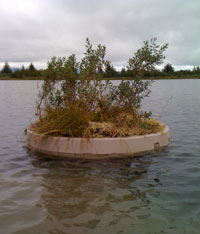Waterfowl Habitat Enhancement Projects
 Over 7 million waterfowl utilize Alaska's coastal tundra and interior boreal forest habitats during the summer months. For the
most part, waterfowl habitat in Alaska remains relatively pristine, but increased urbanization, development activities and global
warming threatens wetland habitat at the local and regional level. As habitat losses increase throughout North America, Alaska's
value in maintaining healthy populations of waterfowl has increased. Many areas important for waterfowl migration, breeding and
staging have been protected within state and federal wildlife refuges. Additionally,
the department partners with other government agencies and non-profit organizations to ensure continued quantity and quality of
habitat.
Over 7 million waterfowl utilize Alaska's coastal tundra and interior boreal forest habitats during the summer months. For the
most part, waterfowl habitat in Alaska remains relatively pristine, but increased urbanization, development activities and global
warming threatens wetland habitat at the local and regional level. As habitat losses increase throughout North America, Alaska's
value in maintaining healthy populations of waterfowl has increased. Many areas important for waterfowl migration, breeding and
staging have been protected within state and federal wildlife refuges. Additionally,
the department partners with other government agencies and non-profit organizations to ensure continued quantity and quality of
habitat.
Pond/Island Creation
 In 1986 and 1987 the department partnered with Ducks Unlimited to construct small scale nesting habitat for waterfowl. These
projects were completed at Palmer Hay Flats State Game Refuge northeast of Anchorage and Creamer's Field Migratory Waterfowl
Refuge in Fairbanks. Their purpose was to test the feasibility of more extensive habitat enhancement projects, and for their
educational value. Nesting habitat was created by excavating several ponds which were interconnected with channels. Islands
were constructed within each pond to provide predator-free nesting habitat. A number of species have been documented using
these areas, including Canada geese, northern pintail, sandhill crane, mallard and northern shoveler.
In 1986 and 1987 the department partnered with Ducks Unlimited to construct small scale nesting habitat for waterfowl. These
projects were completed at Palmer Hay Flats State Game Refuge northeast of Anchorage and Creamer's Field Migratory Waterfowl
Refuge in Fairbanks. Their purpose was to test the feasibility of more extensive habitat enhancement projects, and for their
educational value. Nesting habitat was created by excavating several ponds which were interconnected with channels. Islands
were constructed within each pond to provide predator-free nesting habitat. A number of species have been documented using
these areas, including Canada geese, northern pintail, sandhill crane, mallard and northern shoveler.
Visit
Palmer Hay Flats State Game Refuge
and
Creamer's Field Migratory Waterfowl Refuge for more information.
Dusky Canada Goose Artificial Nest Island Program
 The Dusky Canada Goose breeds primarily within the vast wetland complex on the Copper River Delta (CRD) near the town of Cordova
in south-central Alaska. The 1964 earthquake significantly changed this nesting habitat by altering drainage and allowing terrestrial
predators access to nest sites. Increased predation resulted in a significant population decline. In 1984, an artificial nest island
program was initiated on the CRD to increase nesting success. Nests on these artificial islands are twice as productive as nests at
natural mainland sites. Currently there are 330 islands in place and more are planned. This work is being conducted through a
multi-organizational effort including Chugach National Forest, Oregon Department of Fish and Wildlife, U.S. Fish and Wildlife Service,
Ducks Unlimited, U.S. Geologic Survey - Biological Resource Division, and the Alaska Department of Fish and Game.
The Dusky Canada Goose breeds primarily within the vast wetland complex on the Copper River Delta (CRD) near the town of Cordova
in south-central Alaska. The 1964 earthquake significantly changed this nesting habitat by altering drainage and allowing terrestrial
predators access to nest sites. Increased predation resulted in a significant population decline. In 1984, an artificial nest island
program was initiated on the CRD to increase nesting success. Nests on these artificial islands are twice as productive as nests at
natural mainland sites. Currently there are 330 islands in place and more are planned. This work is being conducted through a
multi-organizational effort including Chugach National Forest, Oregon Department of Fish and Wildlife, U.S. Fish and Wildlife Service,
Ducks Unlimited, U.S. Geologic Survey - Biological Resource Division, and the Alaska Department of Fish and Game.
Visit
Copper River Delta Critical Habitat Area for more information.
Potter Marsh Habitat Enhancement
 Potter Marsh is a coastal freshwater and brackish wetland located at the southern end of the Anchorage Coastal Wildlife Refuge.
The marsh was inadvertently created in 1916 when the Alaska Railroad built an embankment across a tidally influenced shallow cove
in Turnagain Arm. Since that time, the impounded cove transformed into the 540 acre wetland we see today and it supports a wide
variety of waterfowl, shorebirds, fish and other wildlife. Several boardwalks at the edge of the marsh provide wildlife viewing
and educational opportunities to tens-of-thousands of visitors. As early as the 1970s and as recently as 2007, ponds of various
depths were excavated in the marsh to create open water habitat for a wide variety of bird species including dabbling and diving
ducks, and shorebirds. Visit the
Anchorage Coastal Wildlife Refuge for more information.
Potter Marsh is a coastal freshwater and brackish wetland located at the southern end of the Anchorage Coastal Wildlife Refuge.
The marsh was inadvertently created in 1916 when the Alaska Railroad built an embankment across a tidally influenced shallow cove
in Turnagain Arm. Since that time, the impounded cove transformed into the 540 acre wetland we see today and it supports a wide
variety of waterfowl, shorebirds, fish and other wildlife. Several boardwalks at the edge of the marsh provide wildlife viewing
and educational opportunities to tens-of-thousands of visitors. As early as the 1970s and as recently as 2007, ponds of various
depths were excavated in the marsh to create open water habitat for a wide variety of bird species including dabbling and diving
ducks, and shorebirds. Visit the
Anchorage Coastal Wildlife Refuge for more information.
